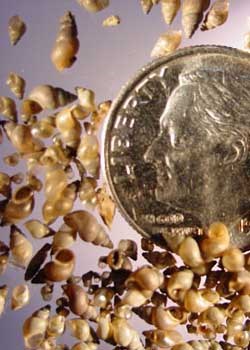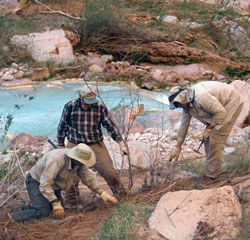Grand Canyon National Parks Marks National Invasive Species Awareness WeekAllyson Mathis 
In 1916, Congress directed the National Park Service to conserve natural and cultural resources unimpaired for the benefit of future generations. Invasive and other exotic (or non-native) species impair park resources by disrupting the canyon's complex ecosystems, frequently reducing biodiversity, modifying or degrading wildlife habitat, and jeopardizing endangered species, such as humpback chub, one of the four remaining species of native fish in the Colorado River in Grand Canyon. 
National Invasive Species Awareness Week is coordinated by the National Invasive Species Council which is co-chaired by the Secretaries of Interior, Agriculture and Commerce. The Council was established by Executive Order 13112 to ensure that federal programs and activities to prevent and control invasive species are coordinated, effective and efficient. Invasive species are exotic species that degrade the environment, impact native species, cause economic impacts, and threaten human health and well-being. 
U.S. Geological Survey Grand Canyon National Park faces serious threats from invasive plants, non-native fish species, aquatic nuisance species such as the New Zealand mudsnail, as well as brown-headed cowbirds and non-native bison/cattle hybrids on the North Rim. Invasive plants that threaten park ecosystems include tamarisk, Sahara mustard, diffuse knapweed, cheatgrass, and other species. Invasive Plants
To date, 196 exotic plant species have been documented within park boundaries. These species represent about 11% of the total number of plant species that occur in the park, and managers estimate that non-native plants may occur in nearly 50% of the park, vastly altering the canyon's natural plant communities. 
Staff survey for new arrivals each year, focusing on roadways, boundaries, trails, park entrances, the river corridor and developed areas where new invasive species are likely to occur through the inadvertent spreading by visitors.
In 2011, park staff identified four new exotic arrivals, one of which, yellow bluestem, is an aggressive grass that appears to be spreading rapidly in Arizona. 
Last year, the park began a new program to help control invasive plants in established campsites along the Colorado River. In the Adopt-a-Camp program, professional river guides removed high priority invasive plants from selected river campsites following protocols provided by the park. 
Control of invasive tamarisk in tributaries is a major component of the park's invasive plants program and has been ongoing since 2002. The project has focused on tributaries and side canyons, which contain high quality desert riparian habitat and retain their natural hydrology. To date, more than 290,000 tamarisk trees have been removed from at least 130 tributaries. 
The next year, the park began an aggressive project to eradicate Himalaya blackberry at Indian Garden that was complemented by planting native vegetation to replace the exotic plants, eliminating this threat to the park's riparian ecosystems. Arizona grape, cattail, red bud, coyote willow, and other native species now thrive along Garden Creek, providing food and shelter to a myriad of wildlife species. Invasive Animals
Non-native fish, especially rainbow and brown trout, have become abundant in the altered aquatic ecosystem of the Colorado River, and in some tributaries. Today, at least 13 species of non-native fish are found in the park, and only four of the eight native species remain. Non-native fish species prey on and/or compete with native fish. Brown trout are particularly voracious predators of native fish. Grand Canyon National Park is conducting a multi-year project to reduce the number of brown and rainbow trout in Bright Angel Creek in order to restore the drainage's native fish community, to the extent feasible. Learn more about this project... 
Biologists are using two methods for capturing and removing non-native trout from Bright Angel Creek during the fall and winter months: a weir, or fish trap, and electro-fishing. The weir captures adult trout that live in the Colorado River as they enter Bright Angel Creek to spawn. 
Bison were brought to U.S. Forest Service land on the Kaibab Plateau in 1906 in an effort to breed them with cattle to produce hybrids, an experiment that was not economically successful. Today, the herd that resulted from this breeding effort is managed by the Arizona Game and Fish Department with the House Rock Valley Wildlife Area designated as bison range. 
These efforts to eliminate or reduce the impacts caused by the invasive and/or exotic tamarisk, blackberry, trout, and bison are not the only management actions taken by the Division of Science and Resource Management in Grand Canyon National Park. The park contains at least 196 species of non-native plants, four species of non-native mammals, six non-native bird species, and 13 species of non-native fish, all of which threaten the canyon's natural ecosystems. Furthermore, there is always the possibility that other invasive species will enter the park and pose new threats to the park's native plants and animals. Chief of Science and Resource Management Martha Hahn said, "Control of invasive species is one of many resource management issues that require integrated planning. We are working at the watershed and landscape level, actively engaging with park neighbors, keeping the public informed, and enlisting the assistance of volunteers to protect Grand Canyon from the damage caused by invasive species. We are proud to celebrate our invasive species mitigation accomplishments during National Invasive Species Awareness Week, and are also taking this opportunity to reflect on our commitment to protecting Grand Canyon's biological diversity from the threats posed by exotic species." To learn more about volunteer opportunities to help control invasive plants in Grand Canyon: To learn more about National Invasive Species Council: Return to the Canyon Sketches Home Page |
Last updated: February 24, 2015
